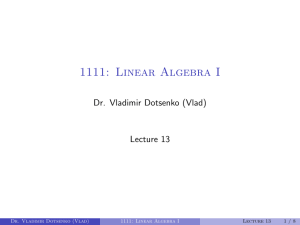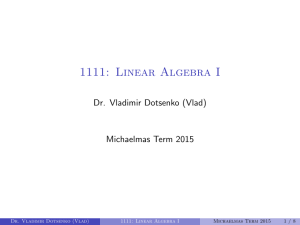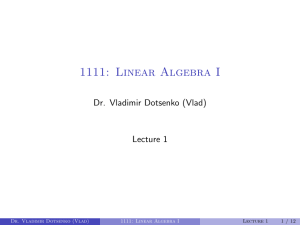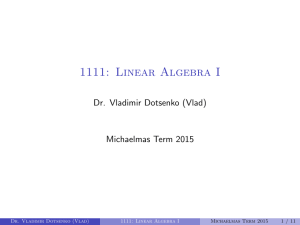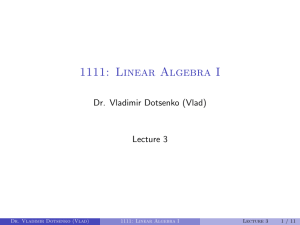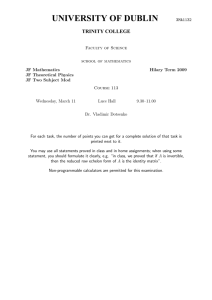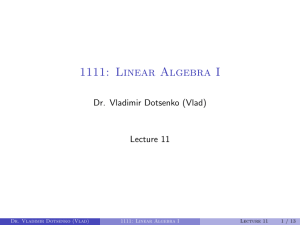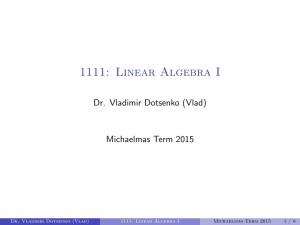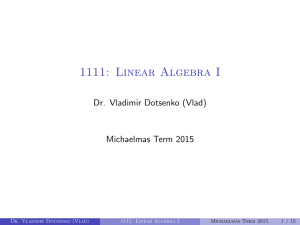1111: Linear Algebra I Dr. Vladimir Dotsenko (Vlad) Lecture 2 1 / 7
advertisement
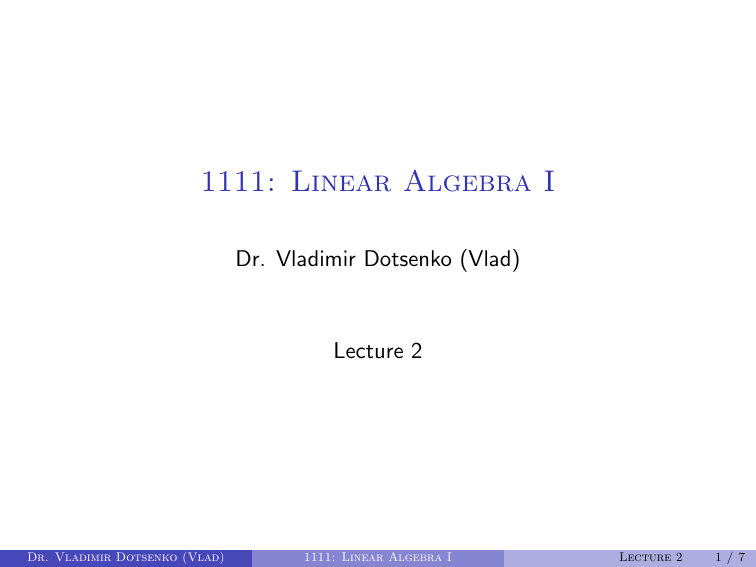
1111: Linear Algebra I Dr. Vladimir Dotsenko (Vlad) Lecture 2 Dr. Vladimir Dotsenko (Vlad) 1111: Linear Algebra I Lecture 2 1/7 Properties of scalar product Theorem. For any vectors v, w, w1 , w2 , and any number c, we have v · w = w · v, v · (w1 + w2 ) = v · w1 + v · w2 , v · (cw) = c(v · w), v · v = |v|2 . Moreover, the scalar product v · w is equal to the product of magnitudes of the vectors times the cosine of the angle φ between them: v · w = |v||w| cos φ . Dr. Vladimir Dotsenko (Vlad) 1111: Linear Algebra I Lecture 2 2/7 Properties of scalar product Proof . All statements except for the last one trivially follow from the definition (plus, in the next-to-last one, the Pythagoras Theorem). Let us prove the last statement. Because of the triangle rule for adding vectors and the Cosine Theorem, we have 1 |v||w| cos φ = (|v|2 + |w|2 − |w − v|2 ) = 2 1 2 2 = ((a + b + c 2 ) + (a12 + b12 + c12 ) − (a − a1 )2 − (b − b1 )2 − (c − c1 )2 ) = 2 = aa1 + bb1 + cc1 . Corollary. For any vectors v and w, we have −|v||w| ≤ v · w ≤ |v||w| . Note that this statement is trivial from the geometric viewpoint (since cos φ is berween −1 and 1), but is harder to infer algebraically. Dr. Vladimir Dotsenko (Vlad) 1111: Linear Algebra I Lecture 2 3/7 Vector product Vector product (cross product): algebraically, if v has coordinates a, b, c and w has coordinates a1 , b1 , c1 , then, by definition, v × w has coordinates bc1 − b1 c, ca1 − c1 a, ab1 − a1 b . For example, for the “standard unit vectors” i, j, and k, we have i × i = j × j = k × k = 0, i × j = k = −j × i, j × k = i = −k × j, k × i = j = −i × k. Dr. Vladimir Dotsenko (Vlad) 1111: Linear Algebra I Lecture 2 4/7 Vector product There is a useful mnemonic rule to memorise vector products of standard unit vectors. Draw a triangle with vertices labelled i, j, k, and sides directed i → j → k → i: j i k Then the vector product of two different standard unit vectors is equal to plus or minus the third one, plus if the order of factors agrees with the direction of the arrow, and minus otherwise, e.g. j × i = −k, because the arrow is directed from i to j. Dr. Vladimir Dotsenko (Vlad) 1111: Linear Algebra I Lecture 2 5/7 Properties of vector product Theorem. For any vectors v, w, w1 , w2 , and any number c, we have v × w = −w × v, v × (w1 + w2 ) = v × w1 + v × w2 , v × (cw) = c(v × w), v × v = 0, u · (v × w) = −v · (u × w), u × (v × w) = (u · w)v − (u · v)w. Note that the property (u × v) × w = u × (v × w) is not satisfied for vector products, making it very different from products of numbers. The property that does hold instead is the so called “Jacobi identity” (u × v) × w + (v × w) × u + (w × u) × v = 0. Dr. Vladimir Dotsenko (Vlad) 1111: Linear Algebra I Lecture 2 6/7 Properties of vector product Proof . All statements except for the last two trivially follow from the definition. The next-to-last one is already somewhat tedious but not yet a disaster. We have u · (v × w) = u1 (v2 w3 − v3 w2 ) + u2 (v3 w1 − v1 w3 ) + u3 (v1 w2 − v2 w1 ), v · (u × w) = v1 (u2 w3 − u3 w2 ) + v2 (u3 w1 − u1 w3 ) + v3 (u1 w2 − u2 w1 ), so we can directly see that these two quantities add up to zero. The last property, meanwhile, is an equation involving some thirty terms, so even though in principle it does follow from the definition, checking it by hand is a “cruel and unusual punishment” (which should be avoided, see, e.g. Eighth Amendment to the United States Constitution). Therefore, we shall explain how one of the key ideas of linear algebra — that of linearity — can be used to simplify the proof dramatically. Dr. Vladimir Dotsenko (Vlad) 1111: Linear Algebra I Lecture 2 7/7
